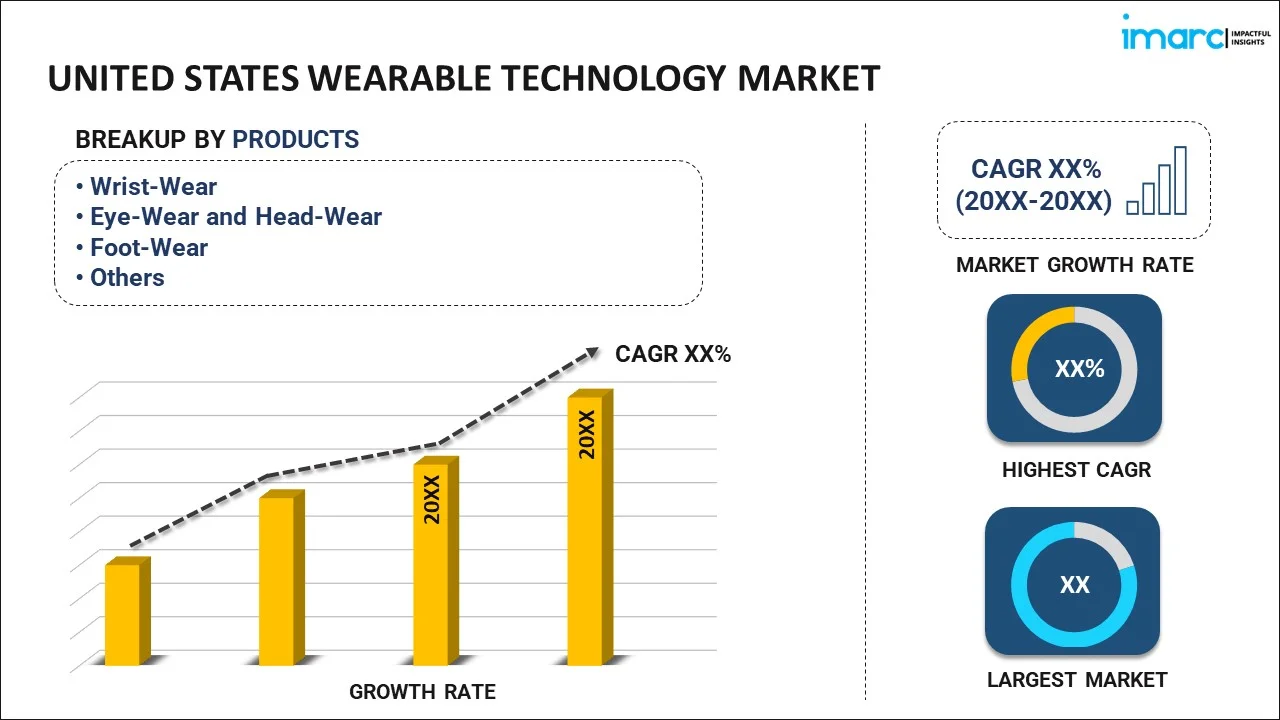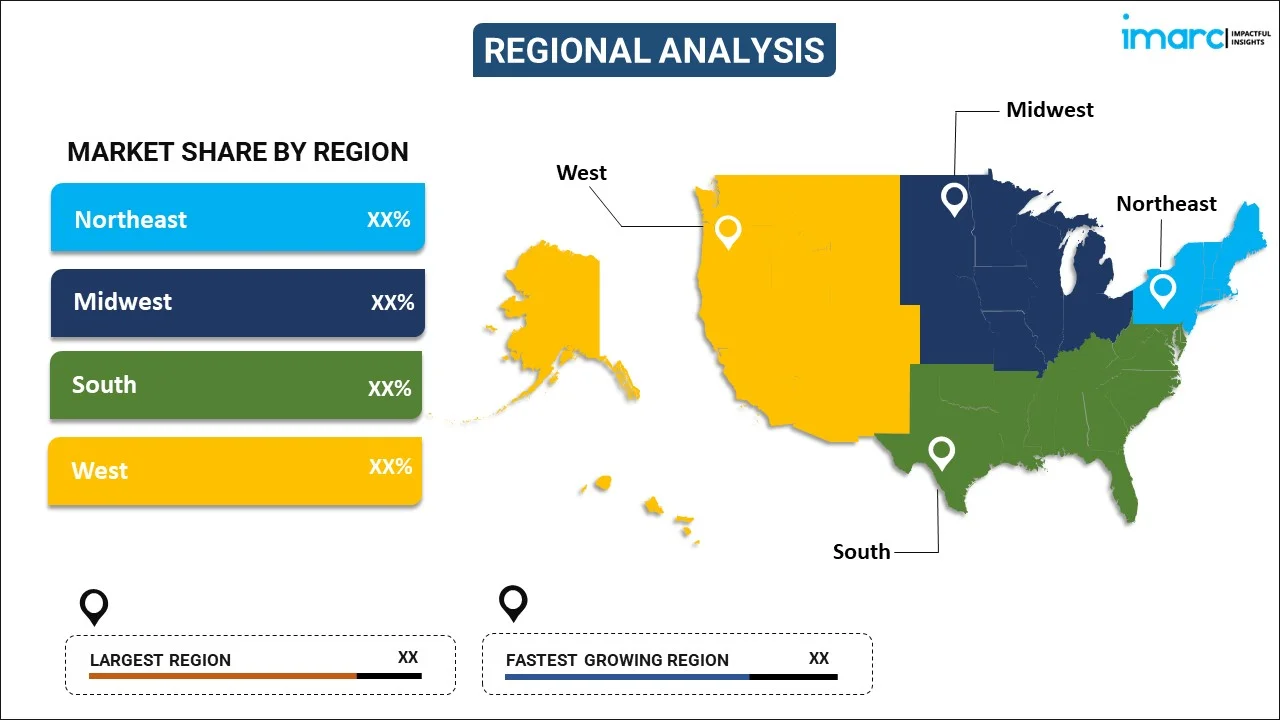
United States Wearable Technology Market Report by Product (Wrist-Wear, Eye-Wear and Head-Wear, Foot-Wear, Neck-Wear, Body-Wear, and Others), Application (Consumer Electronics, Healthcare, Enterprise and Industrial Application, and Others), and Region 2025-2033
Market Overview:
The United States wearable technology market size is projected to exhibit a growth rate (CAGR) of 16.25% during 2025-2033. The increasing awareness and focus on personal health and fitness, continuous improvement in sensor technology, the incorporation of artificial intelligence (AI) and machine learning (ML), and the rising popularity of corporate wellness programs represent some of the key factors driving the market.
|
Report Attribute
|
Key Statistics
|
|---|---|
|
Base Year
|
2024 |
|
Forecast Years
|
2025-2033 |
|
Historical Years
|
2019-2024
|
| Market Growth Rate (2025-2033) | 16.25% |
Wearable technology refers to electronic devices designed to be worn on the body that are equipped with smart sensors and connectivity features to exchange data with other devices or networks. It is available in various types, such as smartwatches, fitness trackers, smart glasses, wearable cameras, smart clothing, and medical devices like heart rate monitors and advanced hearing aids. Wearable technology is manufactured using lightweight metals, polymers, and flexible electronic components, emphasizing comfort and durability. It is utilized in various applications, such as fitness and health monitoring, hands-free communication, navigation, augmented reality (AR), sleep tracking, remote patient monitoring, sports performance analysis, safety monitoring in hazardous environments, smart payments, and fashion tech integration. Wearable technology offers enhanced personal safety, improved health and fitness tracking, convenience, real-time data access, personalized feedback, efficient energy usage, increased productivity, and accessibility for the differently-abled. Moreover, it is known for its portability, ease of use, better engagement, hands-free operation, personalized experience, innovative design, and connectivity with other smart devices.
United States Wearable Technology Market Trends:
The increasing awareness and focus on personal health and fitness is one of the major factors boosting the market growth. Moreover, the widespread adoption of wearable devices like fitness trackers and smartwatches that monitor vital health metrics, such as heart rate, sleep patterns, and physical activity levels, is positively impacting the market growth. Besides this, the continuous improvement in sensor technology, battery life, and data processing capabilities, making wearable devices more efficient, accurate, and user-friendly, is creating a positive outlook for the market growth. Additionally, the incorporation of artificial intelligence (AI) and machine learning (ML) to enhance device capability and provide personalized insights and recommendations is driving the market growth. In addition to this, the integration of wearable technology into fashion and lifestyle products, as designers and technology companies collaborate to create aesthetically pleasing devices that complement personal style, is providing an impetus to the market growth. Furthermore, the rising popularity of corporate wellness programs as companies in the United States adopt wearable technology to monitor and promote healthy habits among employees is anticipated to drive the market growth. Along with this, the growing adoption of wearable technology in the healthcare sector for remote patient monitoring tools is providing a thrust to the market growth. Apart from this, the expansion of fifth-generation (5G) networks and improved connectivity, enhancing the functionality of the devices and allowing for faster data transfer and better integration with other smart devices and systems, is acting as a growth-inducing factor.
United States Wearable Technology Market Segmentation:
IMARC Group provides an analysis of the key trends in each segment of the market, along with forecasts at the country level for 2025-2033. Our report has categorized the market based on product and application.
Product Insights:

- Wrist-Wear
- Eye-Wear and Head-Wear
- Foot-Wear
- Neck-Wear
- Body-Wear
- Others
The report has provided a detailed breakup and analysis of the market based on the product. This includes wrist-wear, eye-wear and head-wear, foot-wear, neck-wear, body-wear, and others.
Application Insights:
- Consumer Electronics
- Healthcare
- Enterprise and Industrial Application
- Others
A detailed breakup and analysis of the market based on the application have also been provided in the report. This includes consumer electronics, healthcare, enterprise and industrial application, and others.
Regional Insights:

- Northeast
- Midwest
- South
- West
The report has also provided a comprehensive analysis of all the major regional markets, which include Northeast, Midwest, South, and West.
Competitive Landscape:
The market research report has also provided a comprehensive analysis of the competitive landscape in the market. Competitive analysis such as market structure, key player positioning, top winning strategies, competitive dashboard, and company evaluation quadrant has been covered in the report. Also, detailed profiles of all major companies have been provided.
United States Wearable Technology Market Report Coverage:
| Report Features | Details |
|---|---|
| Base Year of the Analysis | 2024 |
| Historical Period | 2019-2024 |
| Forecast Period | 2025-2033 |
| Units | Million USD |
| Scope of the Report | Exploration of Historical Trends and Market Outlook, Industry Catalysts and Challenges, Segment-Wise Historical and Future Market Assessment:
|
| Products Covered | Wrist-Wear, Eye-Wear and Head-Wear, Foot-Wear, Neck-Wear, Body-Wear, Others |
| Applications Covered | Consumer Electronics, Healthcare, Enterprise and Industrial Application, Others |
| Regions Covered | Northeast, Midwest, South, West |
| Customization Scope | 10% Free Customization |
| Post-Sale Analyst Support | 10-12 Weeks |
| Delivery Format | PDF and Excel through Email (We can also provide the editable version of the report in PPT/Word format on special request) |
Key Questions Answered in This Report:
- How has the United States wearable technology market performed so far and how will it perform in the coming years?
- What has been the impact of COVID-19 on the United States wearable technology market?
- What is the breakup of the United States wearable technology market on the basis of product?
- What is the breakup of the United States wearable technology market on the basis of application?
- What are the various stages in the value chain of the United States wearable technology market?
- What are the key driving factors and challenges in the United States wearable technology?
- What is the structure of the United States wearable technology market and who are the key players?
- What is the degree of competition in the United States wearable technology market?
Key Benefits for Stakeholders:
- IMARC’s industry report offers a comprehensive quantitative analysis of various market segments, historical and current market trends, market forecasts, and dynamics of the United States wearable technology market from 2019-2033.
- The research report provides the latest information on the market drivers, challenges, and opportunities in the United States wearable technology market.
- Porter's five forces analysis assist stakeholders in assessing the impact of new entrants, competitive rivalry, supplier power, buyer power, and the threat of substitution. It helps stakeholders to analyze the level of competition within the United States wearable technology industry and its attractiveness.
- Competitive landscape allows stakeholders to understand their competitive environment and provides an insight into the current positions of key players in the market.
Need more help?
- Speak to our experienced analysts for insights on the current market scenarios.
- Include additional segments and countries to customize the report as per your requirement.
- Gain an unparalleled competitive advantage in your domain by understanding how to utilize the report and positively impacting your operations and revenue.
- For further assistance, please connect with our analysts.
 Inquire Before Buying
Inquire Before Buying
 Speak to an Analyst
Speak to an Analyst
 Request Brochure
Request Brochure
 Request Customization
Request Customization




.webp)




.webp)












